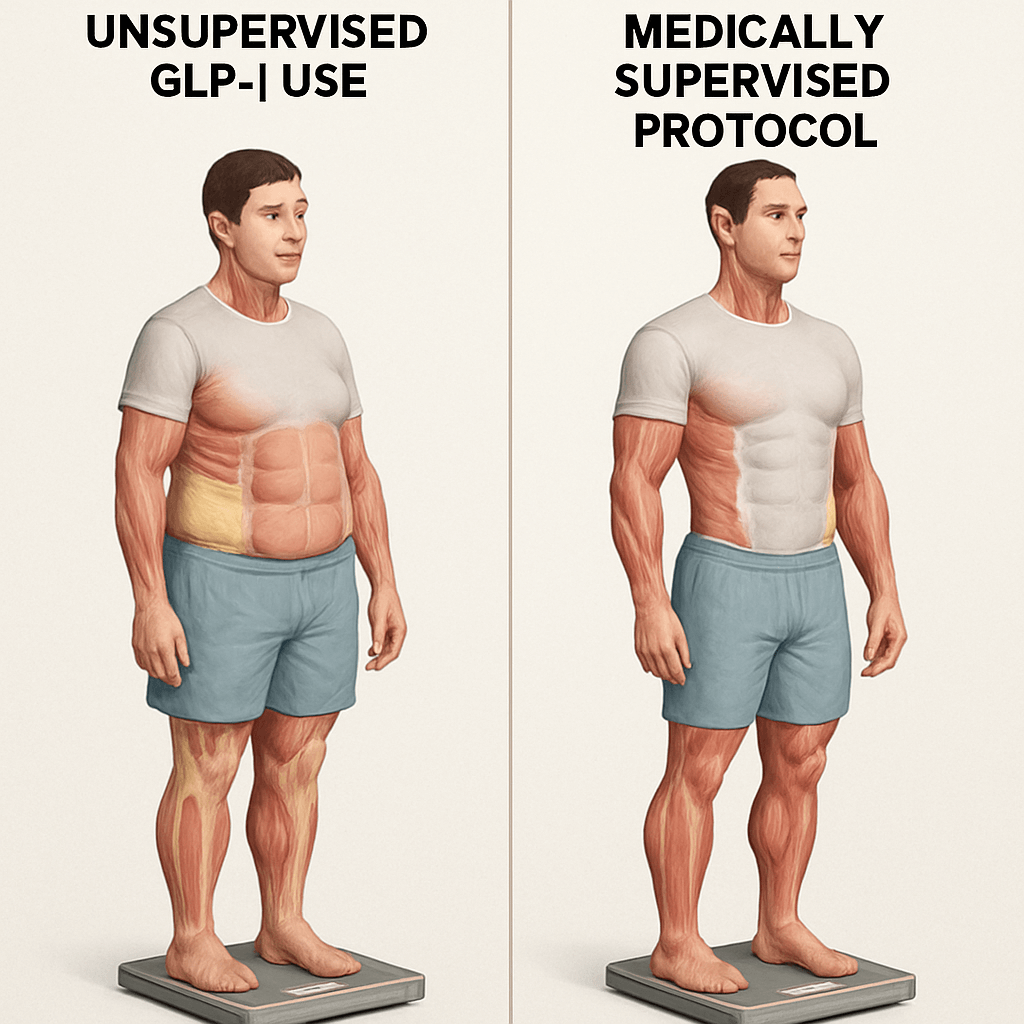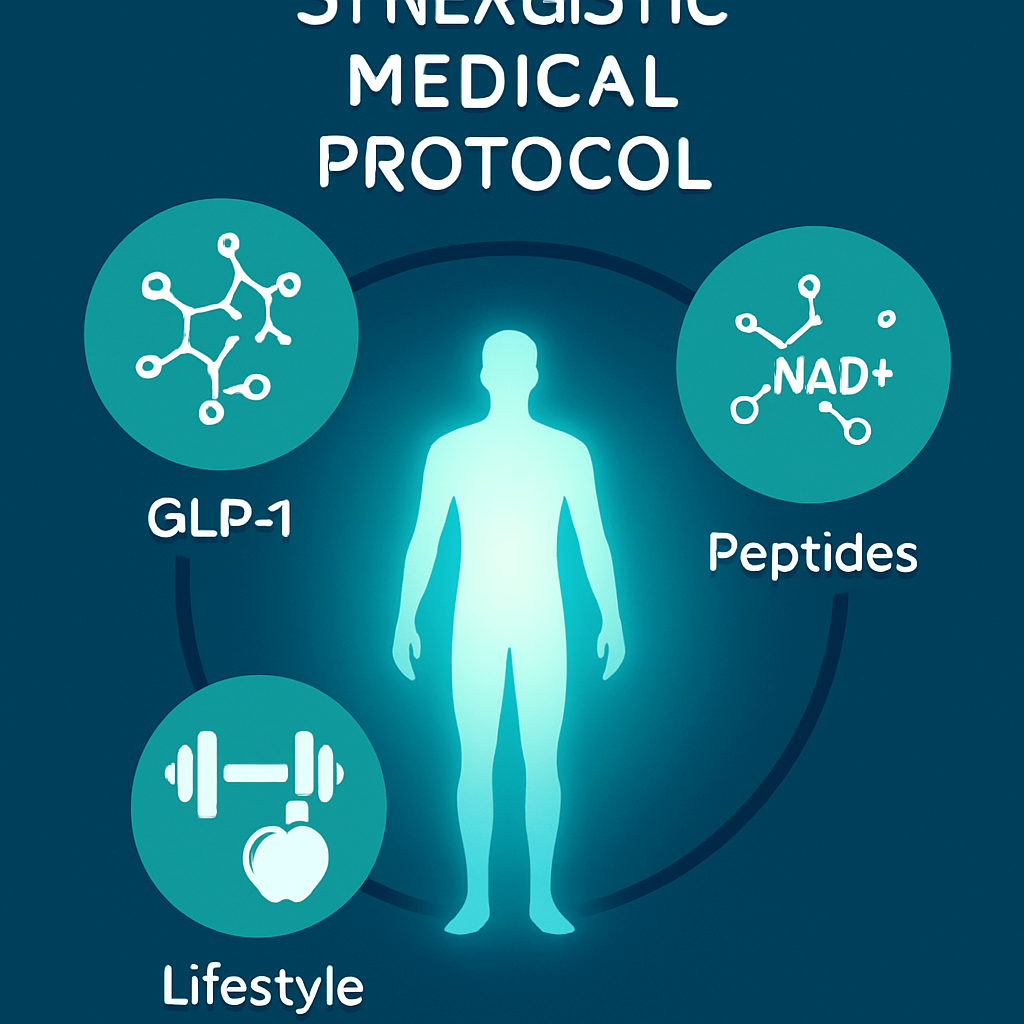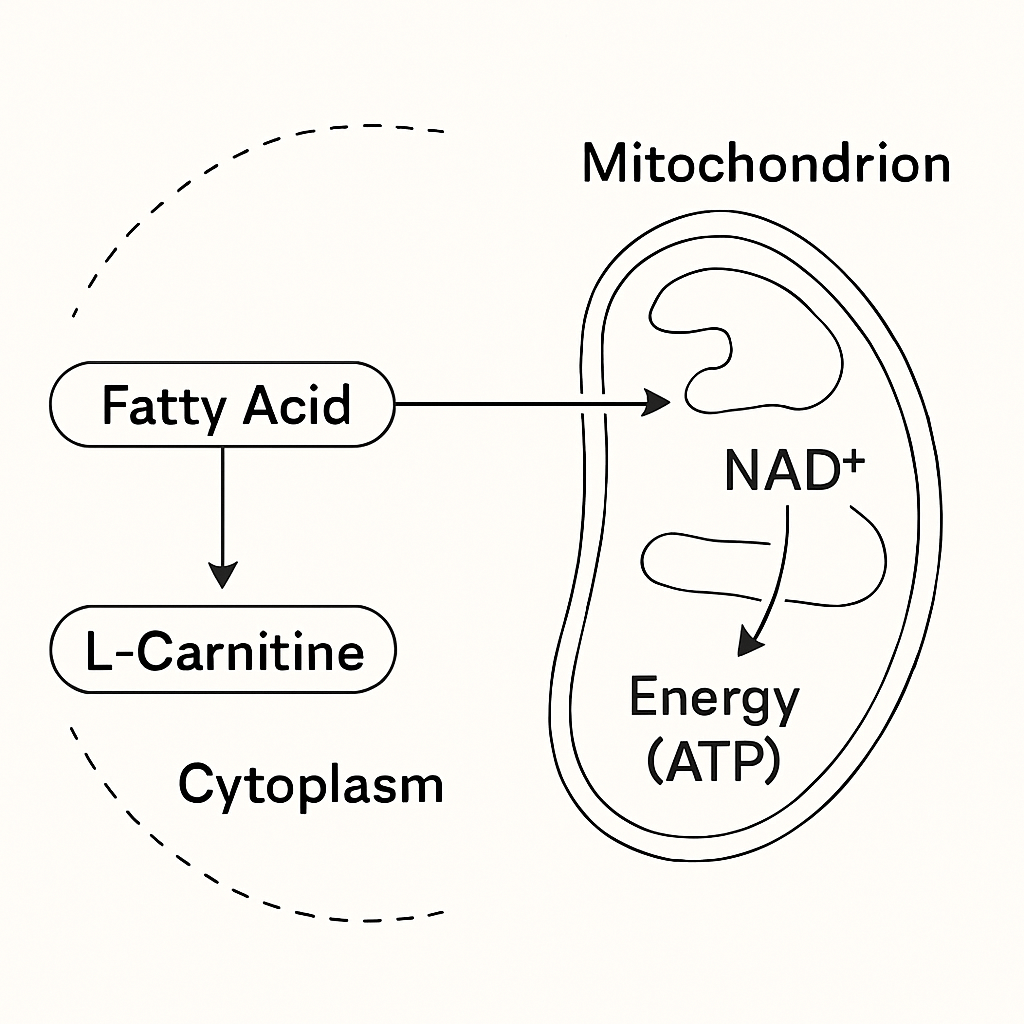
Beyond Ozempic: How Compounded GLP-1s with Peptides Optimize Weight Loss and Preserve Muscle
Beyond Ozempic: How Compounded GLP-1s with Peptides Optimize Weight Loss and Preserve Muscle
You've heard about the incredible weight loss results from GLP-1 medications, but you've also heard the warnings: significant muscle loss that can lead to a "skinny fat" appearance and a damaged metabolism. What if you could get the fat loss benefits without sacrificing your strength and long-term health? This is a common concern for many patients who are rightfully cautious about their health journey.
This guide moves beyond the hype to provide a definitive medical roadmap. We will address the risks and rewards of compounded GLP-1s head-on and reveal the medically supervised, synergistic protocol that combines these powerful medications with specific peptides and lifestyle changes. The goal is simple and clear: to ensure you lose fat, not precious muscle. Drawing on extensive clinical experience and established medical research, this compounded GLP-1 protocol is designed by medical professionals to provide a safer, more effective path to superior body composition and sustainable health.
Table of Contents
The "Skinny Fat" Problem: Deconstructing GLP-1-Induced Muscle Loss
The Synergistic Solution: A Medically Supervised Protocol for Body Composition
Understanding the Landscape: The Compounded GLP-1 Dilemma
To make an informed decision about your health, it's essential to understand the full context of compounded medications. This means transparently addressing the reasons patients seek them out, as well as the critical safety considerations that must be part of the conversation. Building trust starts with acknowledging both the benefits and the potential pitfalls.
Why Compounded GLP-1s? Cost, Availability, and Access
GLP-1 receptor agonists, sold under brand names like Ozempic® (semaglutide) and Mounjaro® (tirzepatide), have proven to be highly effective for weight loss and glycemic control. However, their success has led to two significant challenges for patients: widespread shortages and high costs, which are often not covered by insurance for weight management.
This is where compounded medications enter the picture. Drug compounding is the process by which a licensed pharmacist combines or alters ingredients to create a medication tailored to the needs of an individual patient. When a drug appears on the FDA's drug shortage list, compounding pharmacies are legally permitted to prepare a compounded version to ensure patient access. This provides a vital lifeline for many, offering a more affordable and accessible alternative. Patients often seek compounded semaglutide or compounded tirzepatide to continue their treatment without interruption and at a fraction of the cost of the brand-name drugs.
The Critical Safety Question: Legality, Risks, and Vetting Your Pharmacy
While compounding provides a solution, it also introduces a critical need for due diligence. The FDA does not review or approve compounded drugs for safety and efficacy in the same way it does for mass-manufactured pharmaceuticals. This places the responsibility for quality and safety squarely on the compounding pharmacy and the prescribing physician. The market is unfortunately populated by unregulated online sources selling products that may be impure, incorrectly dosed, or not sterile.
Finding a safe compounded GLP-1 depends entirely on the quality of its source. It is imperative to work only with a state-licensed compounding pharmacy that adheres to strict quality and sterility standards.
Patient safety is non-negotiable. When considering a compounded medication, the first step is to verify the pharmacy's credentials. Ask if they are a 503A or 503B licensed facility and request a Certificate of Analysis (CoA) for their active pharmaceutical ingredients. A reputable pharmacy will be transparent about their sourcing, testing, and sterilization processes. Sourcing medication from anywhere other than a verified, state-licensed U.S. pharmacy introduces unacceptable risks that no patient should ever take.

Verifying the Safety of Compounded Medications
The "Skinny Fat" Problem: Deconstructing GLP-1-Induced Muscle Loss
One of the most significant concerns surrounding rapid weight loss with GLP-1s is the potential for sarcopenia, or the loss of muscle mass. While the number on the scale may be dropping, the loss of metabolically active muscle tissue can have serious long-term consequences, leading to the dreaded "skinny fat" outcome—a state where an individual has a low body weight but a high body fat percentage and low muscle mass.

The 'Skinny Fat' Outcome vs. Healthy Body Composition
Why Rapid Weight Loss Can Target Muscle
GLP-1 medications work primarily by suppressing appetite, which leads to a significant reduction in calorie intake. When the body is in a steep calorie deficit, it seeks energy from all available sources. While the primary goal is to burn stored fat, the body can also turn to breaking down muscle tissue for fuel—a process known as catabolism. This risk of GLP-1 muscle loss is especially high if the weight loss is rapid and not supported by adequate protein intake and resistance training.
Without a specific strategy to signal the body to preserve muscle, a significant portion of the weight lost can come from lean body mass. This is the scientific basis for the sarcopenia concerns that have been widely reported. The body essentially sees muscle as an "expensive" tissue to maintain during a period of perceived famine and may sacrifice it to conserve energy.
The Long-Term Impact: Metabolism, Strength, and Rebound Weight Gain
Losing muscle has consequences that extend far beyond physical appearance or strength. Lean muscle mass is a primary driver of your basal metabolic rate (BMR)—the number of calories your body burns at rest. When you lose muscle, your BMR drops. This means your body requires fewer calories to function, making it progressively harder to continue losing weight and dangerously easy to regain it.
Research from institutions like Massachusetts General Hospital has highlighted the metabolic challenges that follow significant weight loss. When muscle is lost, the body's metabolic engine slows down. If a person stops taking the GLP-1 medication and returns to their previous eating habits, their new, slower metabolism cannot handle the caloric load. This often leads to rapid rebound weight gain, with the regained weight being predominantly fat, worsening their overall body composition and making future weight loss attempts even more difficult. This vicious cycle underscores why preserving muscle is not just an aesthetic goal but a crucial component of long-term metabolic health.
The Synergistic Solution: A Medically Supervised Protocol for Body Composition

The Three Pillars of a Synergistic Weight Loss Protocol
A truly effective medical weight loss program does not just focus on the number on the scale; it focuses on improving body composition. The goal is to maximize fat loss while actively preserving, or even building, lean muscle mass. This requires a multi-faceted, synergistic approach where medication is just one part of a comprehensive, medically supervised plan.
Pillar 1: The GLP-1 Engine (Compounded Semaglutide/Tirzepatide)
The compounded GLP-1 medication serves as the powerful engine of this protocol. By effectively regulating appetite and improving insulin sensitivity, it creates the necessary caloric deficit to initiate fat loss. It gives patients the control they need to make healthier food choices without battling constant hunger. However, this engine must be steered by the other pillars of the protocol to ensure it moves the patient toward the right destination: healthy, sustainable body composition.
Pillar 2: Protecting Muscle & Enhancing Fat Burn with Peptides
To counteract the catabolic effects of a calorie deficit and enhance the body's fat-burning capabilities, specific adjunctive therapies are integrated into the protocol. These peptides for weight loss and other compounds work synergistically with the GLP-1 medication.

How Peptides Boost Cellular Fat Burning
MIC (Methionine, Inositol, Choline) & L-Carnitine
This combination of lipotropic agents plays a crucial role in fat metabolism. A MIC injection, often combined with L-Carnitine, helps the body mobilize stored fat. Methionine, Inositol, and Choline are essential for liver function and the breakdown and transport of fats. L-carnitine acts as a shuttle, transporting these mobilized fatty acids into the mitochondria—the "powerhouses" of our cells—so they can be burned for energy. By improving the efficiency of fat as a fuel source, this combination helps spare muscle protein from being used for energy.
NAD+
Nicotinamide Adenine Dinucleotide (NAD+) is a vital coenzyme found in every cell of the body, central to energy production and metabolic processes. As we age, NAD+ levels naturally decline. NAD+ therapy aims to replenish these levels, which can help boost cellular metabolism, improve energy levels, and reduce the fatigue sometimes associated with a low-calorie diet. By supporting mitochondrial health and efficient energy production, NAD+ helps ensure the body is functioning optimally during the weight loss process.
Pillar 3: The Non-Negotiable Holistic Framework
Medications and peptides alone are not a magic bullet. Lasting success and safety are only possible when they are integrated into a holistic framework that includes targeted nutrition and exercise. This is a non-negotiable part of any responsible medical weight loss protocol.
Resistance Training
To prevent muscle loss, you must give your body a compelling reason to keep its muscle. The most powerful signal you can send is through resistance training. Engaging in GLP-1 resistance training—such as lifting weights, using resistance bands, or bodyweight exercises—stimulates muscle fibers, signaling the body to repair and maintain them. This is a direct command to preserve lean mass, even while in a calorie deficit. A typical recommendation is 2-3 full-body sessions per week, focusing on compound movements.
High-Protein Nutrition
Nutrition provides the building blocks to protect your muscle. A high-protein diet is essential during GLP-1 therapy. Protein promotes satiety, helping you feel fuller for longer, and provides the necessary amino acids for muscle protein synthesis. Without adequate protein, your body cannot repair the muscle stimulated during resistance training, and it may break down existing muscle to get the amino acids it needs. A common medical guideline is to consume 1.2 to 1.6 grams of protein per kilogram of ideal body weight daily.
A Practical Toolkit: Your Patient Safety Checklist
Empowering yourself with the right information is the most important step in any health journey. Use this checklist to guide conversations with your healthcare provider and compounding pharmacy. A trustworthy medical team will welcome these questions and provide clear, transparent answers.
Critical Questions to Ask Before Starting a Compounded GLP-1 Protocol
For Your Provider:
How will we monitor my body composition to ensure I am losing fat, not muscle? (e.g., InBody scans, DEXA)
What is my personalized daily protein target in grams?
What specific resistance training guidelines should I follow to protect my muscle mass?
How often will we have check-ins to monitor my progress and adjust the protocol as needed?
For Your Compounding Pharmacy:
Are you a 503A or 503B licensed pharmacy in the United States?
Can you provide a current Certificate of Analysis (CoA) for the base ingredients (active pharmaceutical ingredients) you use?
What are your sterility testing protocols for injectable medications?
Conclusion
Compounded GLP-1 medications can be a powerful and accessible tool for weight loss, but they must be used intelligently within a comprehensive medical framework. Simply chasing a number on the scale while ignoring muscle loss is a short-sighted strategy that can compromise your long-term metabolic health.
A holistic, medically supervised protocol that integrates synergistic peptides, targeted resistance training, and high-protein nutrition is the only responsible way to achieve healthy, sustainable fat loss. This approach ensures you protect your muscle, support your metabolism, and truly transform your body composition. Don't just lose weight; work with a medical team to build a stronger, healthier body for the long term. This is the path to achieving results that are both safe and effective.
MDRX Network, LLC
Phone: 832-500-7888
Email: [email protected]
